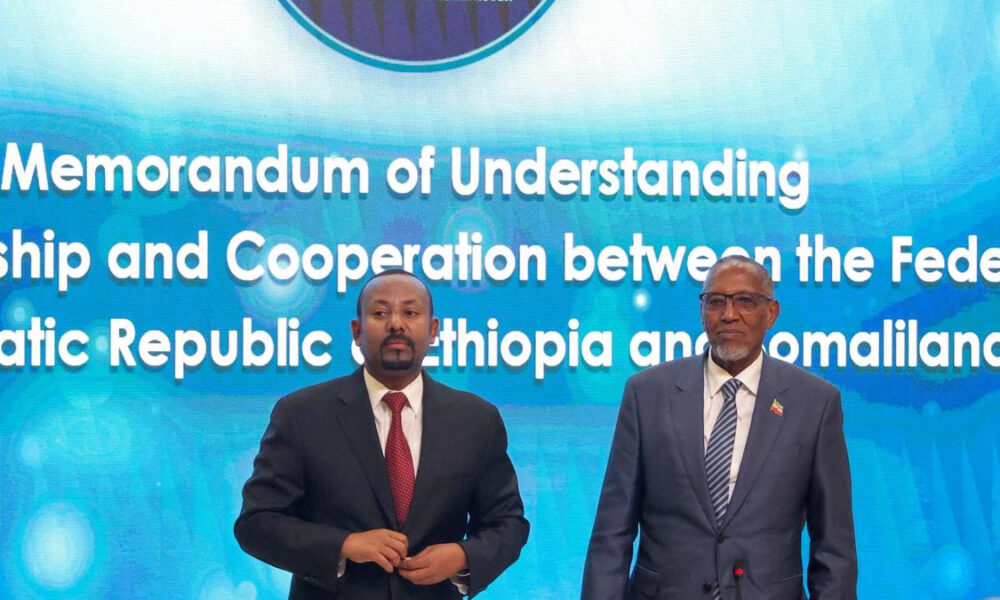by Hari Prasad Shrestha 3 January 2024
Ethiopia signed what is known as a memorandum of understanding (MoU) with the self-declared republic of Somaliland to use one of its ports to pave the way to realize the aspiration of Ethiopia to secure access to the sea.
Ethiopia’s Prime Minister Abiy Ahmed signed a memorandum of understanding with Somaliland’s President Muse Bihi Abdi in Addis Ababa. Speaking at the signing ceremony, Mr Abdi said the agreement included a section stating that Ethiopia would recognise Somaliland as an independent country at some point in the future. This recognition came in “exchange for 20km (12 miles) sea access for the Ethiopian naval forces, leased for a period of 50 years”.
Somalia rejected a pact its breakaway region of Somaliland signed with Ethiopia allowing it to use a major port with access to the Red Sea in return for recognition as an independent state, saying the agreement had no legal force. Somalia, which views Somaliland as part of its territory, also summoned its ambassador to Ethiopia for deliberations over the agreement signed by Ethiopian Prime Minister Abiy Ahmed and Somaliland leader Muse Bihi Abdi .
Somaliland seceded from Somalia more than 30 years ago, but is not recognised by the African Union (AU) or the UN as an independent state. It is an autonomous region in northern Somalia, which broke away and declared independence from Somalia in 1991. Somaliland, officially the Republic of Somaliland, is an unrecognized sovereign state in the Horn of Africa, recognised internationally as de jure part of Somalia. The capital and largest city is Hargeisa. The government of Somaliland regards itself as the successor state to British Somaliland, which, as the briefly independent State of Somaliland, united from 1960 to 1991 with the Trust Territory of Somaliland (the former Italian Somaliland) to form the Somali Republic.
On 26 June 1960, the protectorate gained independence as the State of Somaliland and five days later voluntarily united with the Trust Territory of Somaliland, following its separate independence, to form the Somali Republic. The British Somaliland and Italian Somaliland become independent and merge to form the Somali Republic.A lawful union occurred between the two territories through their elected representatives. On 27 June 1960, the Legislative Assembly of Somaliland unanimously enacted an Act of Union with Somalia which stated that the two entities would forever remain united. In 1961, Somalia took control of state institutions, which was rejected in the former State of Somaliland and resulted in the Somaliland residents boycotting the vote on the Somali constitution. In December 1961, the revolt in the north was started by soldiers of the former State of Somaliland who took control of large cities in the north. A group of officers took control of the radio station in Hargeisa, declaring the end of the unity between Somalia and Somaliland.
In April 1981, the Somali National Movement (SNM) was founded, which led to the Somaliland War of Independence. In 1988, at the height of the war, the regime in Somalia under the dictator Siad Barre began a crackdown against the Hargeisa-based SNM and other militant groups, which were among the events that led to the Somali Civil War.The conflict left Somalia’s economic and military infrastructure severely damaged. The conflict was in response to the harsh policies enacted by the Barre regime against the main clan family in Somaliland, the Isaaq, including a declaration of economic warfare on the Isaaq. These harsh policies were put into effect shortly after the conclusion of the disastrous Ogaden War in 1978.
Since 1991, the territory has been governed by democratically elected governments that seek international recognition as the government of the Republic of Somaliland. The central government maintains informal ties with some foreign governments, who have sent delegations to Hargeisa. Somaliland is currently recognised by the Republic of China (Taiwan) and hosts representative offices from several other countries, most notably Ethiopia. However, Somaliland’s self-proclaimed independence has not been officially recognised by any UN member state or international organization. It is the largest unrecognized state in the world by de facto controlled land area. It is a member of the Unrepresented Nations and Peoples Organization, an advocacy group whose members consist of indigenous peoples, minorities and unrecognized or occupied territories.
In August 2000, President Egal’s government distributed thousands of copies of the proposed constitution throughout Somaliland for consideration and review by the people. One critical clause of the 130 individual articles of the constitution would ratify Somaliland’s self-declared independence and final separation from Somalia, restoring the nation’s independence for the first time since 1960. In late March 2001, President Egal set the date for the referendum on the Constitution for 31 May 2001.
A constitutional referendum was held in Somaliland on 31 May 2001. The referendum was held on a draft constitution that affirmed Somaliland’s independence from Somalia. 99.9% of eligible voters took part in the referendum and 97.1% of them voted in favor of the constitution. Somaliland has political contacts with its neighbors Ethiopia and Djibouti,non-UN member state Republic of China (Taiwan), as well as with South Africa,Sweden,the United Kingdom,and the micronation of Liberland.

